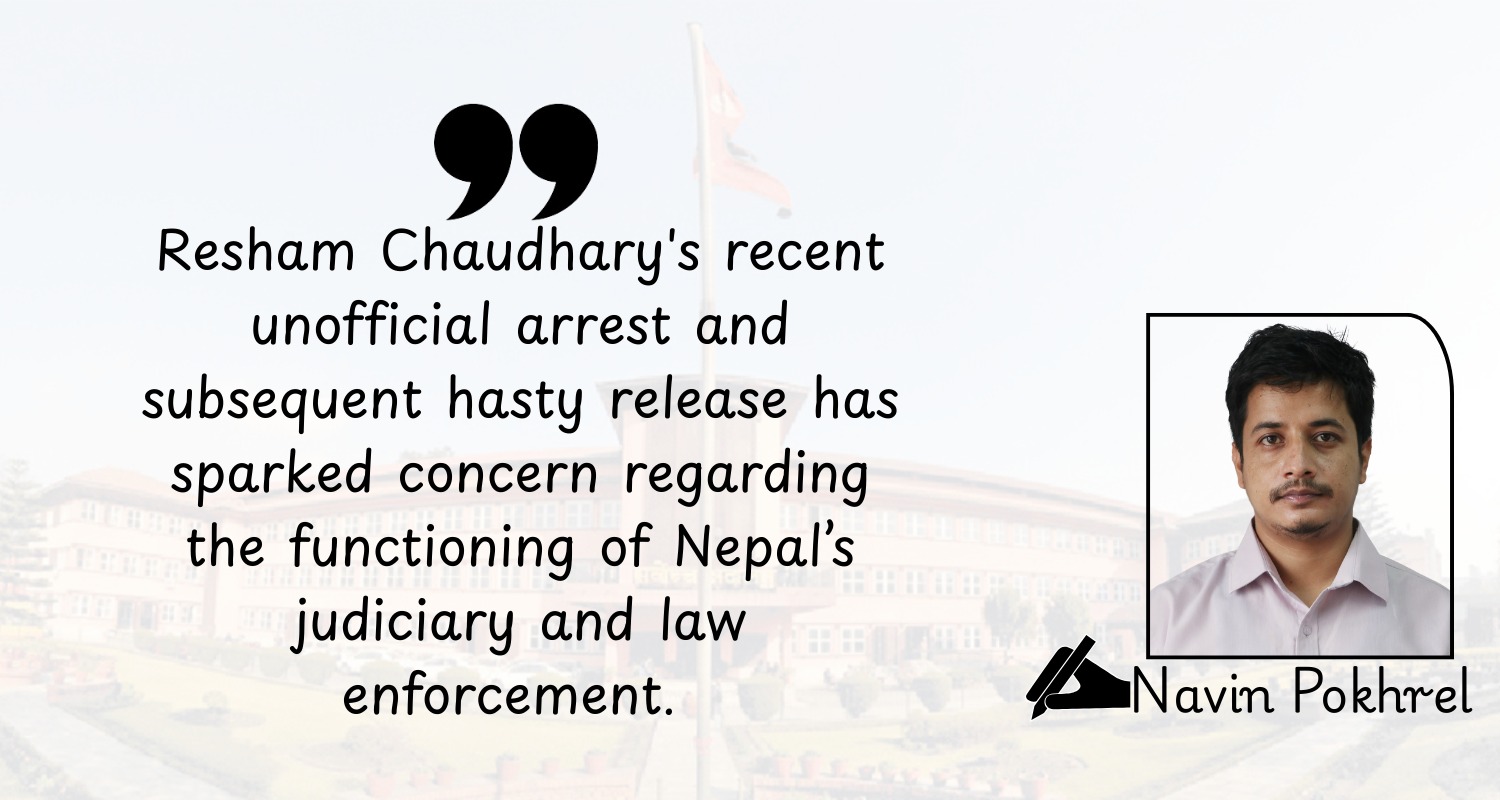
-Navin Pokhrel
Resham Chaudhary’s recent unofficial arrest and subsequent hasty release has sparked concern regarding the functioning of Nepal’s judiciary and law enforcement. At face value, it is tempting to view this as a striking example of Praxiscam- “the realm of makeshift government where politics is a patchy system of lies and administrative security gaps are exploited.” Upon further scrutiny, however, this seems to be the outcome of individual malpractice against a backdrop of ambiguity in parts of law enforcement, rather than an orchestrated government conspiracy.
Upholding Constitutional Principles Amidst Challenges
The Constitution of Nepal guarantees judicial independence, the rule of law, separation of powers, all of which are cornerstones of democracy. These tenets are meant to protect the ensure justice from political meddling and law enforcement from arbitrary executive shackles. The initial arrest, on the human fabrication of a Supreme Court document, violates these principles and aggravates problems towards the borders of administrative and judicial aberrations.
The deep-cutting personal malfeasance of officer Bista whose name is placed in the stamp of authority, is indeed deeply rooted in the conduct that spins within the precincts of that court which he occupies, but pragmatically, the broader intentions of the court or the government does not policy of either. The acts of the officer behind the deceptive Supreme Court facade could strictly be for the purposes of a single overlord devoid of an irritating crown puzzle of an endemic governance disaster.
Strategic Ambiguities and Gaps in Security Provision within Law Enforcement
Most of the Nepalese law enforcement agencies must function under very difficult conditions that are generally characterized by:
➢ Unclear procedures for verification of judicial orders;
➢ Disintegrated information flow between the police, judiciary and the administrations;
➢ Inadequate training and means to recognize produced forgeries and unauthorized commands;
➢ Expectations and ambiguity in politically sensitive matters.
These operational realities can result in wrongful execution of, in the absence of political intentionality. The police compliance with the forged letter was probably more a matter of procedural obscurity than wilful participation in a political scam.
Two Perspectives: Systemic Masquerade vs. Standalone Deviation
Praxiscam Perspective: The occurrence: epitomizes a deep-seated politicization of administrative frauds to the detriment of justice and governance. It indicates an Epsteinian systemic failure in the of constitutional checks, begging for immediate action.
Isolated Malpractice Perspective: This is an unfortunate, yet isolated incident attributable to individual deviance and operational disarray. The institutions of the government and the judiciary, despite the negative spotlight, have shown commitment to the rule of law, and therefore this incident requires in-system reviews and strengthen designs instead of condemnation.
A Holistic Approach for Understanding and Reformation
The Resham Chaudhary case should be a reason for sober thinking rather than for heated debate and polarized opinions. Be it a part of a Praxiscam or isolationist malpractice, it transcends into the following critical gaps:
➢ Administrative Gaps: The possibility of forgery and execution of judicial documents sans adequate authorization demonstrates the critical lack of validation and supervision added unto an unchecked surveil mechanism.
➢ Security Gaps: Enforcement bodies: Operational gray areas combined with inefficient order authentication methods creates gaps within the system that can be maliciously utilized or otherwise.
➢ Responsibility Congruence Gaps: Prevention of reoccurrence on arrest and grant procedures requires stronger accountability measures and better training for law enforcement officers on legal borders of their functions.
➢ Judicial Independence and Transparency: Constitutionally set requirements must investigate and transform procedures that erode trust toward judiciary while nurture autonomy.
The governance and judicial arena in Nepal need not utilize the finger-pointing strategy but endeavour to ensure the interlocking gaps of personal errors alongside systematic failures. Justice and democratic governance in which ever deepening the political turmoil of Nepal survives within would only be guaranteed lessons unlearned deemed avoided through comprehensive reforms blended with rigid administrative structure, lucid operational processes, and unwavering constitutional allegiance.
Author’s Note: Esta is a reflection of Nepal’s Chaudhary Resham Case as a ‘Shìjiàn’ gives us an insight into the merits and demerits of Nepal’s democracy. It seeks the attention of all the players such as the state, the courts, the police, law practitioners, social organizations and the public in building the schemes of justice and governance.
Comments